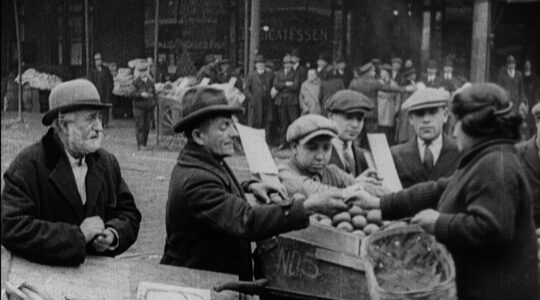When Norman Mailer set out to write about Marilyn Monroe, he kept a bottle of her perfume, open, on his desk, a writerís stimulant.Ashley Lazarus, director and co-producer of the new film ìRashi: A Light After The Dark Ages,î opens any Chumash and there he is, Rashi, a fragrance still wafting through Jewish life from almost a millennium away. Lazarus, a South African ÈmigrÈ, studies Rashi with a blind rabbi who fingertips the Torah in Braille. Lazarus reads Rashi aloud and the blind can see.
Rashi, the greatest rabbinic play-by-play man of all time, whose sentence-by-sentence dissection of the Talmud and Torah makes the obscure into the obvious. Heís the greatest, but hardly self-referential. What do we know about him, actually?Rabbi Beryl Wein, the Jewish historian, knows that Rashi was a hero, and we are a community for whom the struggle for Jewish literacy itself has become heroic. Rashi script? We struggle reading standard Hebrew block letters. His place in history? Most of us canít place Rashiís life within 500 years or 500 miles.
We can go to the movies, though, so if the mountain canít come to Rashi, Rashi comes to the mountain. Rabbi Wein formed Destiny Films to produce dramas examining the private and public lives of Jewish leaders and scholars who changed the destiny of, well, you and me.ìRashiî is the inaugural film, available in video, animated in watercolors as delicate and dreamlike as a dulcimer. With the voices of Leonard Nimoy as Rashi, Armand Assante as the Elijah-like Inkman, and Paul Schofield as narrator, itís an adult animation, without Disneyís wacky animal sidekicks.
Lazarusí fellow producer, Emmy Award winner Allan Leicht, says, Rashiís ìheart was in Torah but his fingers were literally in the ground, growing grapes. He was a French Jew, a wine maker in the vineyards of Champagne. Perhaps the most magical thing about him is that a 7-year-old can learn the same Rashi as a 95-year-old rebbe. He is at once a treasure and a challenge. A challenge, because essentially he was an intellect, and ideas are not what movies are about. Movies are almost never about ideas; theyíre about action. This is about his ideas, his time, and what made him timeless.îOf course, there is action, too: Living in the 11th century, just after the Dark Ages and on the lip of the Crusades is enough action for most Jews, thank you.
For most of us, growing up, Rabbi Solomon ben-Isaac ó Rashi to his friends ó was simply the teacher who wrote in that odd script. Rashi script, we call it ó an optical version of a tongue twister. Yet, he never actually saw or wrote in that script in his life. In the 15th century, some 300 years after Rashi last dipped quill in ink, when Hebrew Scripture was first finding its way to that newfangled invention, the printing press, a printer, seeking to differentiate Rashiís commentary from the Torah text, set Rashiís words in a Sephardic Ladino typeface; a font thereafter known as ìRashi.
His birth was enveloped in legends, tales of precious gems and churning seas, threats from pagans, heavenly voices. Modern women are inspired by stories of Rashiís daughters wearing tefillin; only legend. The old women tell tall tales of Rashiís pregnant mother being imperiled in an alley when a stone wall miraculously indents to give her shelter; legends more revealing of our love than of his life.
Youíll notice we only put one legend in the whole film,î says Lazarus, ìthat Duke Godfrey de Boullion, the leader of the French Crusaders to Jerusalem, returned to Troyes, Rashiís home. And the narrator says right away that this was likely a legend. Why didnít we put in all the wonderful legends? We would have ended up with a mythological Rashi and we didnít want to do that. We wanted to portray him exactly as we understood him, particularly from his own written rabbinic responses.
So maybe his daughters didnít put on tefillin, but itís documented that Rashi taught them Talmud. His compassion is documented as well, says screenwriter Jesse Cogan, in a case in which Rashi paid a comforting shiva call to a family, even after they ignored his reminder that it was impermissible to sit shiva on a holy day. Everything is based on something real that happened.îCogan says that itís unclear when Rashi was born but we know when he died (1105), ìwhich is a testament to his being famous in his own time. They didnít keep histories then, nothing. Itís not clear whether he had two daughters or three daughters; thereís no mention of his wife. But knowing that the Crusaders were heading for Jerusalem,î puts a different shine on Rashiís very first verse, in which he writes that the Torah begins with the Creation story, rather than the first mitzvah, to assert that God created the world and the Land of Israel belonged to Him, not the hordes who were heading there on horseback.Cogan adds, ìWe know for a fact that Rashiís works got into the Christian community.
This is Coganís first screenplay, but he is a much honored advertising man who created the ìTurn Friday Night Into Shabbosî campaign. His first documentary, ìNothingís Changed,î about a child survivor of the Holocaust returning to the Ukrainian forests and villages where he hid, was just acclaimed at the Northampton (Mass.) Film Festival in early November. In October, ìRashiî won ìBest Animationî at the Atlantic City Film Festival.ìAnimation looks for bigger than life situations,î explains Cogan. One spectacular sequence is Rashiís hometown Troyes market fair, a layered depiction of fire-eaters and 11th century exotics. ìWe know,î says Cogan, ìthat Rashi knew about almost everything,î from silk embroidery to banking to engraving and agriculture. ìWe know that Rashi never left Troyes after he settled there,î so his wisdom must have been supplemented at these mercantile extravaganzas.
But how do you animate Rashi? What does he look like?Lazarus says, ìWe based his face on the Chofetz Chaim, Rav Zalman Auerbach and Rav Moshe Feinstein, as well as poses from other gedolim [rabbinic greats], such as the Lubavitcher rebbe.îWhy the Chofetz Chaim, say? ìHis kindness. When you read all the teshuvas [rabbinic responses] from Rashi, and his commentary, itís Rashiís kindness and compassion that shines through.îRashi, we hardly knew ye.
The New York Jewish Week brings you the stories behind the headlines, keeping you connected to Jewish life in New York. Help sustain the reporting you trust by donating today.




